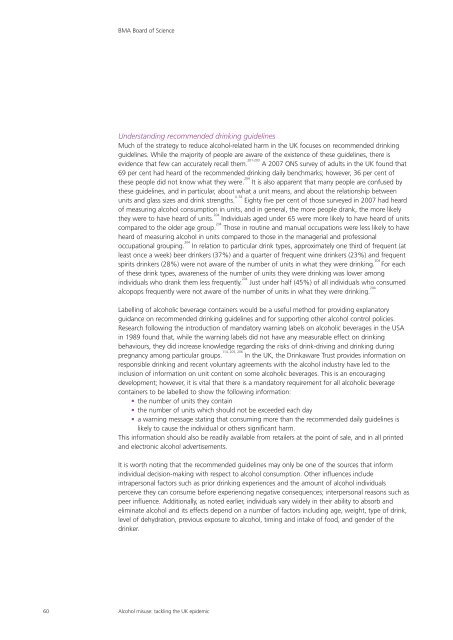Alcohol misuse: tackling the UK epidemic - London
Alcohol misuse: tackling the UK epidemic - London
Alcohol misuse: tackling the UK epidemic - London
You also want an ePaper? Increase the reach of your titles
YUMPU automatically turns print PDFs into web optimized ePapers that Google loves.
60<br />
BMA Board of Science<br />
Understanding recommended drinking guidelines<br />
Much of <strong>the</strong> strategy to reduce alcohol-related harm in <strong>the</strong> <strong>UK</strong> focuses on recommended drinking<br />
guidelines. While <strong>the</strong> majority of people are aware of <strong>the</strong> existence of <strong>the</strong>se guidelines, <strong>the</strong>re is<br />
evidence that few can accurately recall <strong>the</strong>m. 201-203<br />
A 2007 ONS survey of adults in <strong>the</strong> <strong>UK</strong> found that<br />
69 per cent had heard of <strong>the</strong> recommended drinking daily benchmarks; however, 36 per cent of<br />
<strong>the</strong>se people did not know what <strong>the</strong>y were. 204<br />
It is also apparent that many people are confused by<br />
<strong>the</strong>se guidelines, and in particular, about what a unit means, and about <strong>the</strong> relationship between<br />
4, 54<br />
units and glass sizes and drink strengths. Eighty five per cent of those surveyed in 2007 had heard<br />
of measuring alcohol consumption in units, and in general, <strong>the</strong> more people drank, <strong>the</strong> more likely<br />
<strong>the</strong>y were to have heard of units. 204<br />
Individuals aged under 65 were more likely to have heard of units<br />
compared to <strong>the</strong> older age group. 204<br />
Those in routine and manual occupations were less likely to have<br />
heard of measuring alcohol in units compared to those in <strong>the</strong> managerial and professional<br />
occupational grouping. 204<br />
In relation to particular drink types, approximately one third of frequent (at<br />
least once a week) beer drinkers (37%) and a quarter of frequent wine drinkers (23%) and frequent<br />
spirits drinkers (28%) were not aware of <strong>the</strong> number of units in what <strong>the</strong>y were drinking. 204<br />
For each<br />
of <strong>the</strong>se drink types, awareness of <strong>the</strong> number of units <strong>the</strong>y were drinking was lower among<br />
individuals who drank <strong>the</strong>m less frequently. 204<br />
Just under half (45%) of all individuals who consumed<br />
alcopops frequently were not aware of <strong>the</strong> number of units in what <strong>the</strong>y were drinking. 204<br />
Labelling of alcoholic beverage containers would be a useful method for providing explanatory<br />
guidance on recommended drinking guidelines and for supporting o<strong>the</strong>r alcohol control policies.<br />
Research following <strong>the</strong> introduction of mandatory warning labels on alcoholic beverages in <strong>the</strong> USA<br />
in 1989 found that, while <strong>the</strong> warning labels did not have any measurable effect on drinking<br />
behaviours, <strong>the</strong>y did increase knowledge regarding <strong>the</strong> risks of drink-driving and drinking during<br />
114, 205, 206<br />
pregnancy among particular groups. In <strong>the</strong> <strong>UK</strong>, <strong>the</strong> Drinkaware Trust provides information on<br />
responsible drinking and recent voluntary agreements with <strong>the</strong> alcohol industry have led to <strong>the</strong><br />
inclusion of information on unit content on some alcoholic beverages. This is an encouraging<br />
development; however, it is vital that <strong>the</strong>re is a mandatory requirement for all alcoholic beverage<br />
containers to be labelled to show <strong>the</strong> following information:<br />
<strong>the</strong> number of units <strong>the</strong>y contain<br />
<strong>the</strong> number of units which should not be exceeded each day<br />
a warning message stating that consuming more than <strong>the</strong> recommended daily guidelines is<br />
likely to cause <strong>the</strong> individual or o<strong>the</strong>rs significant harm.<br />
This information should also be readily available from retailers at <strong>the</strong> point of sale, and in all printed<br />
and electronic alcohol advertisements.<br />
It is worth noting that <strong>the</strong> recommended guidelines may only be one of <strong>the</strong> sources that inform<br />
individual decision-making with respect to alcohol consumption. O<strong>the</strong>r influences include<br />
intrapersonal factors such as prior drinking experiences and <strong>the</strong> amount of alcohol individuals<br />
perceive <strong>the</strong>y can consume before experiencing negative consequences; interpersonal reasons such as<br />
peer influence. Additionally, as noted earlier, individuals vary widely in <strong>the</strong>ir ability to absorb and<br />
eliminate alcohol and its effects depend on a number of factors including age, weight, type of drink,<br />
level of dehydration, previous exposure to alcohol, timing and intake of food, and gender of <strong>the</strong><br />
drinker.<br />
<strong>Alcohol</strong> <strong>misuse</strong>: <strong>tackling</strong> <strong>the</strong> <strong>UK</strong> <strong>epidemic</strong>
















